为什么老年人难以理解当今的科技究竟有发达? [美国媒体]
quora网友:“为什么老人难以理解当今的科技究竟有发达?”为什么?我快要60岁了。我想我大概已经老了(在我18岁的时候,我的女朋友就叫我“老古董”),因此我尝试一直坚持使用电子产品。我小时候那会,黑白电视是常态(一户人家一个,当然有些人家没有,因为电视很贵),而且很少有彩色的电视节目......
Why is it so hard for old people to understand how incredible the technology of today is?
为什么老人难以理解当今的科技究竟有发达?
来源网站:Quora
Timothy Mauch, former Submarine sonar Chief Petty Officer at United States Navy (1976-1991)
蒂莫西·毛奇,前美国海军潜艇声呐军士长(1976-1991)
“Why is it so hard for old people to understand how incredible the technology of today is?”
Why? I’m almost 60. I guess I’m old (when I was 18, my girlfriend called me an “old fuddy-duddy”), so I’ll give it a try. I’ll stick to electronics.
When I was young, Black & White TV was the norm (one per house, and some houses had none, because TVs were very expensive.) and very few TV shows were broadcast in Color. The inside of a TV was full of glowing vacuum tubes. When you turned the TV on, you had to wait a while for the tubes to warm-up, before you saw a picture. There were four networks Three were commercial (ABC, NBC, CBS) and one was educational (PBS). Only very, very expensive TVs had remote control (on/off & channel up/down. It was ultrasonic, and if you jangled a key-chain in the room, the noise would make the TV change channels). Our remote control was Dad yelling at me to get up and change the channel. Everybody watched whatever Dad wanted to watch. When the TV broke, you called the TV repair shop (there was just one telephone in the house, with wires, and it belonged to the only phone company )Pacific Northwest Bell, for us), and a repairman came to fix it. He carried a wooden box (looked like a tool box) FULL of tubes and knew everything about the TV’s circuitry. His van had thousands of tubes and books with the circuitry of every TV.
“为什么老人难以理解当今的科技究竟有发达?”
为什么?我快要60岁了。我想我大概已经老了(在我18岁的时候,我的女朋友就叫我“老古董”),因此我尝试一直坚持使用电子产品。
我小时候那会,黑白电视是常态(一户人家一个,当然有些人家没有,因为电视很贵),而且很少有彩色的电视节目。电视的机箱里充满了发光的电子管。你打开电视后,需要等上一会儿让管子发热,然后才能看到画面。当时有四个电视网,其中三个是商业的(ABC,NBC,CBS),一个是教育的(PBS)。当时只有非常非常昂贵的电视机配有遥控器(开/关/调上个频道/下个频道。遥控器采用的是超声波技术,哪怕你在房间里用钥匙链发出一些声音,噪音就会让电视换频道)。至于我家的遥控方式——我爸对我大吼几声,让我起来换频道。家里每个人都只能看爸爸想看的节目,不论他想看的是什么。如果电视机坏了,你需要打电话给电视修理店(我家那会只有一个电话,有电话线的那种,它属于当时唯一的电话公司:西北太平洋贝尔电话公司),会有一个修理工来修理它。他对电视的线路了如指掌,带着一个里头装满管子的木盒 (看起来像一个工具箱)。他的面包车里有无数根电子管,无数本关于电视电路的书籍。
Black & white TV
黑白电视机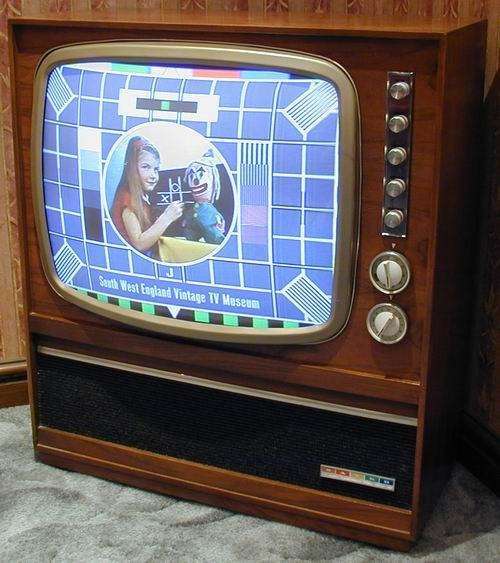
Color TV
彩色电视机
TV Repairman
电视修理工
That’s what got me interested in electronics. Two neighbors were amateur radio operators. One was a women who used it to talk to her husband, serving in Vietnam. That’s what got me interested in amateur radio. In junior high school, our “industrial arts” department had more than just the traditional wood shop and metal shop. It had an electrician shop (including a wooden telephone pole to climb, and a power transformer at the top), and an electronics shop. The electronics shop started at the beginning of broadcast radio, and ended with an AM and Shortwave radio. The building had a long outdoor wire antenna, just like what was used when broadcast radio was first invented, in the ‘20s.
这使得我对电子学感兴趣。我的两个邻居都是业余无线电操作员。其中一位是个女士,她通过无线电和在越南服役的丈夫通讯。由此,我也产生了对业余无线电的兴趣。在初中学校,我们的“工艺美术”系不仅仅配有传统的木工车间和金属加工车间,还有一个电工车间(包括一个可供攀爬木制的电话线杆,顶部还有一个电源变压器)和一个电器商店。这家电器商店始于广播电台兴起之时,在调频广播和短波无线电通信的时代关门。这座大楼顶上有一根很长的天线,就像无线电广播在20年代刚刚被发明时所使用的一样。
Old ham radio
老式业余无线电设备
Ham Radio Tower
业余无线电电塔
o MY first radio was a “crystal” radio, built on a breadboard, using the power of the radio broadcast to put the sounds into a crystal headset.
我的第一台收音机是台矿石收音机,建立在一块底板上,利用无线电的力量把声音传送到耳机里。
Breadboard tube radio experiment.
板管收音机试验
o Then, I added a vacuum tube diode, to make it more reliable.
o A vacuum tube triode added amplification, to make it more sensitive (to hear weaker radio stations). New circuitry made it more selective (to separate the different stations).
o Another vacuum tube was added to make the sounds strong enough to drive a loudspeaker. So, I had a three-tube radio that I built from scratch, just like what people used in the ‘30s.
o Finally, I bought a kit that would become a five-tube radio, operating on the AM broadcast band (to hear local stations), AND on an international shortwave band (to hear broadcasts from other countries).
然后,我添加了一个真空二极管,使它更可靠。
添加一个真空三极管增加放大率,使它更加灵敏(接收更微弱的广播电台)。新的电路使它更有选择性(划分不同的广播电台)。
第三个被添加的真空管,用来使声音大到足够驱动一个扩音器。这样,我有了一个我自己亲手制作的三管收音机,它就跟30年代的人使用的一样。
最后,我买了一套能让它变成五管收音机的设备,能接收到AM广播波段(听当地电台)以及国际短波波段(听其他国家的广播)。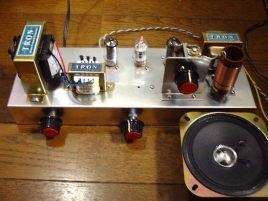
Vacuum Tube Kit Radio
成套电子管收音机
In high school I went to computer programming class to learn how to program our school district’s IBM mainframe computer (which was downtown at school district headquarters) in FORTRAN (one of several languages used on mainframes, the ancestors of today’s C++). The programs were punched onto paper cards, with a key-punch machine we stole from the business department. Each card was one line in the program (such as IF X=5 THEN GOTO 15). The program results came back on wide computer paper (computer monitors were very rare, green characters on a black screen, and only in the computer center, to control the computer). We sent one program per week, on Friday, in a big box. Our programs were run in the middle of the night on a weekend, when computer time was cheapest. The print-outs came back on Monday. Networking hadn’t been invented, yet.
高中时,我上了计算机编程课,学习如何用FORTRAN语言(这是在大型机上使用的几种语言之一,是今天的C++的祖先。译者注: Fortran诞生于上世界五十年代,是世界上第一个高级编程语言)给学区内的IBM(在市中心,是学区内IBM的总部,译者注:IBM,International Business Machines Corporation,IT公司-国际商业机器公司)的大型计算机编写程序 。这些程序被我们用一台从营业部门偷来的键控穿孔机打在了纸卡(译者注:应该是打孔卡)上,一张卡片一行代码(如:X=5后转到15)。程序的结果会输出到计算机用纸上(计算机显示器非常少见,只有计算机中心有,黑色的屏幕上会有绿色的字符,用来操作计算机)。每周五,我们会用一个大盒子运送一个我们的程序。我们的程序会在周末的一个午夜运行计算,因为那个点计算机使用时间是最便宜的,计算结果会在周一出来。那时,网络还没有被发明出来。
Mainframe Computer Center
大型计算机中心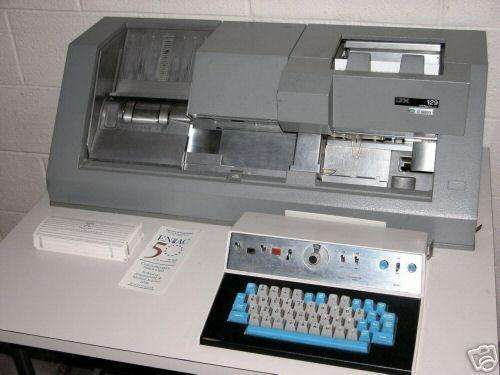
Keypunch Machine
键控穿孔机
I joined the Navy, and went into advanced electronics (sonar, specifically), and was trained to repair all of a submarine’s auxiliary equipment (things like fathometer, underwater communications, sound measurement and analysis), which meant I could serve on any submarine in the fleet (not specialized and restricted). Some equipment was very old, still using vacuum tubes, some was recent digital state-of-the-art. My first two submarines were the oldest in the Navy, with very old equipment sitting next to the newest. Eventually, I moved up to the newest and best equipment and submarine, and even helped to construct the newest and best submarine in the world. After that, I went back to the latest school, to teach young new men everything I knew.
我加入了海军,深入高等电子学方面(特别是声呐),并接受了修理所有潜艇辅助设备的训练(如:测深仪、水下通信、声波测距和分析),这意味着我可以在舰队中的任何潜艇上服役(没有专属、不受限制的)。一些设备很旧,仍然使用真空管,一些则是最先进的数字技术。我最开始的两艘潜艇是海军中最老的型号,有着非常陈旧的设备,停靠在最新的潜艇旁。最终,我移到了有着最新颖最尖端装备的潜艇上,甚至还为建造世界上最先进的潜艇出了一份力。在那之后,我回到了学校,教授年轻的新兵我所知道的一切。
Old Submarine Sonar Console
老式潜艇声呐控制台
New Sonar Consoles
新声呐控制台
During this time, when at home, I started experimenting with home computers. My room-mate had an Apple II, and my brother had an 8-bit PC. I started with a Timex-Sinclair, and later, a Commodore C64. My mother (she was 64) had an expanded TI-99. Another room-mate had an original Apple Macintosh (ugliest computer on the planet, EVER!) At work, we used a Tektronix 4052 and, later, an HP 9836 for auxiliary computations.
在这期间,在家的时候,我开始使用家用电脑。我的室友有一个Apple II/苹果二代(译者注:第二代苹果电脑,沃兹尼亚克[就是曾经和乔布斯合伙创立苹果电脑公司的那位]70年代中期发明,是1970年代及1980年代初期销量最佳的个人电脑),我弟弟有一台8位的个人电脑。我从一台Timex-Sinclair(译者注:辛克莱研究公司发行的小型家用电脑)开始,后来用的是一台Commodore C64/康懋达 64(注:康懋达公司1982年发行)。我的母亲(她那时64岁)有一个扩展的TI-99(注:Texas Instruments expanded 99/4A,美国德州仪器1981发行的家用电脑)。另一位室友有一款原创的Apple Macintosh/苹果麦金塔(绝对是有史以来最丑的电脑,绝对!)。工作的时候,我们使用了Tektronix 4052/泰克4052,后来又使用HP 9836/惠普9836来辅助计算。
Tektronix 4050 Series
泰克4050系列
HP 9836
惠普9836
Timex-Sinclair 1000
辛克莱 1000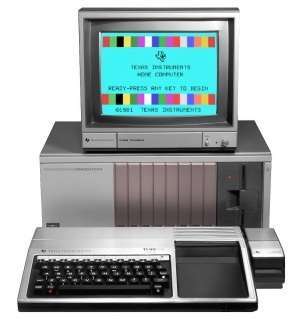
Texas Instruments expanded 99/4A
德州仪器99/4A
Commodore C64
康懋达64
Commodore SX-64
康懋达豪华版64
Apple II
苹果二代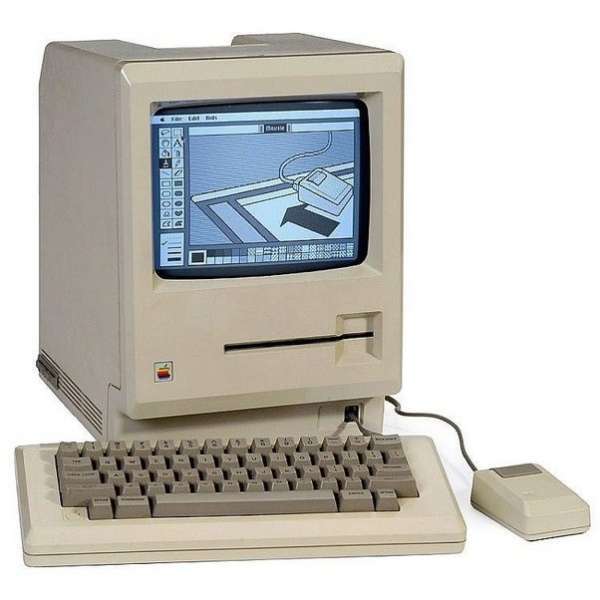
Apple Macintosh
苹果麦金塔
IBM Suitcase PC
IBM手提箱电脑(便携式)
For my own use at work, I bought a Commodore SX64 “suitcase portable” with an outboard CP/M card for word processing, spreadsheets and databases. At home, I eventually built an 8 MHz PC/XT with MS-DOS, running Word Perfect, Lotus 1–2–3 and dBase. Online was CompuServe and Dow Jones News. I had my own online BBS, using FidoNet for email. Al Gore hadn’t invented the Internet, yet (smile). I also got my ham radio license, and started experimenting with computer radio-telecommunications.
I got out of the Navy and became a Radio Broadcast Engineer. The industry was, at that time, transitioning from analog equipment (magnetic tape and vacuum tubes) to the digital of today (VoIP, networks, virtual reality).
就我自己的工作使用,我买了一台“手提箱便携式”Commodore SX64,带有一个外置的CP/M(注:Control Program for Microprocessors ,第一个微机操作系统)卡,用于操作文字处理、电子表格、数据库。在家里,我最终用MS-DOS(注:Microsoft disk operating system,微软磁盘操作系统)改装了一台8兆赫的PC/XT,可以完美地运行Word,Lotus 1-2-3和dBase这些软件。线上有CompuServe(注:当时主要通过电话连接提供网络服务的一个商业组织)和道琼斯新闻。我有自己的线上论坛,通过FidoNet来发电子邮件。但是,阿尔·戈尔还没有发明互联网(微笑)。我也得到了我的业余无线电执照,并开始尝试计算机无线电通讯。
之后我离开海军,成为了一名无线电广播工程师。那个时候,这个行业正发生着从模拟装置(磁带和真空管)到今天的数字化(VoIP、网络、虚拟现实)的蜕变。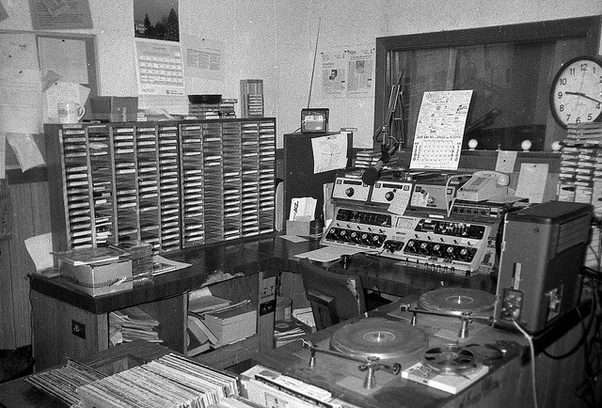
Old Radio Studio
老式播音室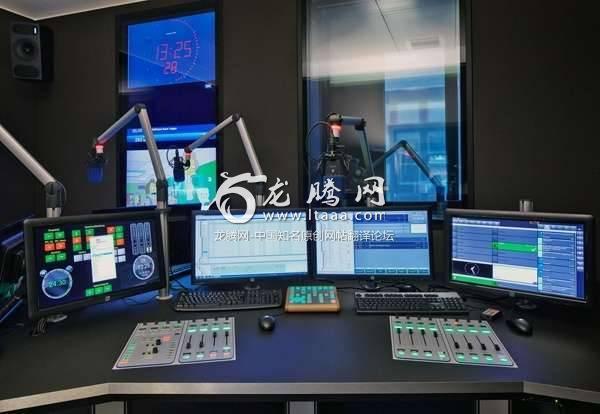
New Radio Studio
新播音室
I’m still building my own PCs. I started with a 300 bps modem, 20MB hard drive and two 5–1/4″ floppies, to a 48 Mbps modem, 10 TB hard drive and blu-ray, installing my own home network and WiFi hotspot. I’m constantly modifying and upgrading everything.
我还在继续改造自己的个人电脑。我从300bps(注:bits per second,比特每秒,计算机或调制解调器的信息传输速度单位)的调制解调器、20MB的硬盘驱动器和两个5–1/4的软盘驱动器,到48 Mbps(注:million bits per second,兆比特每秒)的调制解调器、10 TB硬盘和蓝光,我还安装了我自己的家庭网络和WiFi热点。我不断地修改和升级所有的东西。
I still have all of my old stuff.
o Computers. Timex-Sinclair~Asus PC. Floppies, modems, hard-drives, monitors, web cams, mics, speakers, headsets, routers, whatever.
o Audio. Phonograph, cassette, 8-track, reel-to-reel, MP3, DAT, CD, DVD, MiniDisk.
o Video. Betamax, VHS, laserdisc, DVD, Blu-Ray
o Camera. Polaroid Land, Kodak Instant, 35mm SLR, Pentax DSLR
o Telephones. Rotary, Touch-Tone, cordless, digital, analog cellular bag phones, digital cellular, flip phones, smart phones, Android, iOS, Windows phones, 2G, 3G, LTE.
o 2-way radio. Amateur tube~solid state, CB, GMRS, FRS, MURS, Maritime SSB, Maritime VHF, Air VHF, Morse Code, teletype, fax, Slow Scan TV, analog TV, digital TV.
我仍然留着所有的旧东西。
【电脑】:从Timex-Sinclair 到华硕。软盘、调制解调器、硬盘驱动器、显示器、网络摄像头、麦克风、扬声器、耳机、路由器等等。
【音频】:留声机、磁带、八轨道磁带、卷盘磁带、MP3、数字录音带、CD、DVD、迷你碟。
【视频】:Betamax(Beta制录像系统),VHS(Video Home Syste,家用录像系统),雷射影碟,DVD,蓝光。
【摄像机】:宝丽来相机,柯达拍立得,35mm单反,宾得数码单反。
【电话】:旋转(盘)式电话、按键式电话、无绳电话、数字电话、模拟移动电话、数字蜂窝、翻盖手机、智能手机、Android、iOS、Windows phone、2G、3G、LTE。
【双向无线电收发设备】:民用管状态的及固态的、CB(Citizens’ Band,民用波段)、GMRS(General Mobile Radio Service,通用移动无线电服务)、FRS(Family Radio Service,家庭无线电服务)、MURS(Multi-use Radio Service,多功能无线电服务)、Maritime SSB(Maritime Single Side Band航海单边带)、Maritime VHF(Maritime Very High Frequency)航海甚高频、航空甚高频、摩尔斯电码、电传打字机、传真机、慢扫描电视、模拟电视、数字电视。
I guess you could say that this old codger is fully aware of the incredible technology we have. I’ve been using state-of-the-art technology for 50+ years, from vacuum tubes to micro chips, point-to-point wiring to surface mount devices, lead-cell batteries with acid burns, to lithium batteries that catch fire in your pocket. coal power plants to nuclear ones, wind and solar power. navigating by the stars to GPS, mechanical clocks to digital ones, polio to transplanting everything but your brain.
我猜你可能会说,这个怪老头完全意识得到如今我们所拥有的技术成果有多绮丽。我持续使用顶尖技术已经有50多年了,从真空管到微芯片,从点对点布线到表面贴装器件,从用酸做电解液的铅蓄电池到你的口袋里的锂电池。从燃煤发电厂到核能发电厂,风力发电厂和太阳能发电厂。从星辰指路到GPS,从机械钟表到数字时钟,将小儿麻痹症从你的大脑移除。
And my life is only 2/3s over! What’s next? Fusion? Anti-matter? Miniature singularities? New laws of the universe that ignore the speed of light? Artificial gravity?
Wheee!
我的人生还只过了三分之二!未来还有什么在等待着我?可控核聚变?反物质?微型奇点?无视光速的宇宙新法则?人造重力?
呦吼~~~!
版权声明
我们致力于传递世界各地老百姓最真实、最直接、最详尽的对中国的看法
【版权与免责声明】如发现内容存在版权问题,烦请提供相关信息发邮件,
我们将及时沟通与处理。本站内容除非来源注明五毛网,否则均为网友转载,涉及言论、版权与本站无关。
本文仅代表作者观点,不代表本站立场。
本文来自网络,如有侵权及时联系本网站。
图文文章RECOMMEND
热门文章HOT NEWS
-
1
Why do most people who have a positive view of China have been to ...
- 2
- 3
- 4
- 5
- 6
- 7
- 8
- 9
- 10
推荐文章HOT NEWS
-
1
Why do most people who have a positive view of China have been to ...
- 2
- 3
- 4
- 5
- 6
- 7
- 8
- 9
- 10










